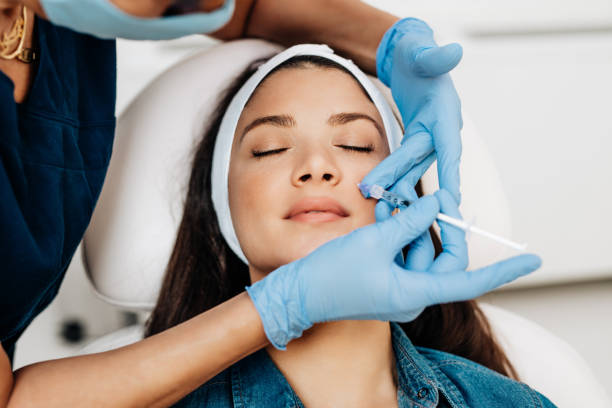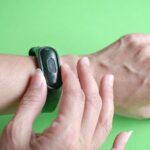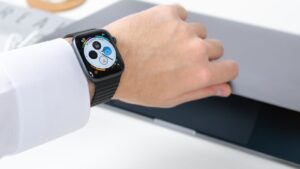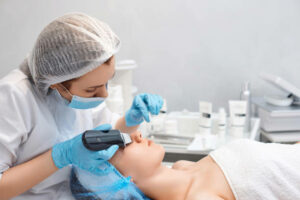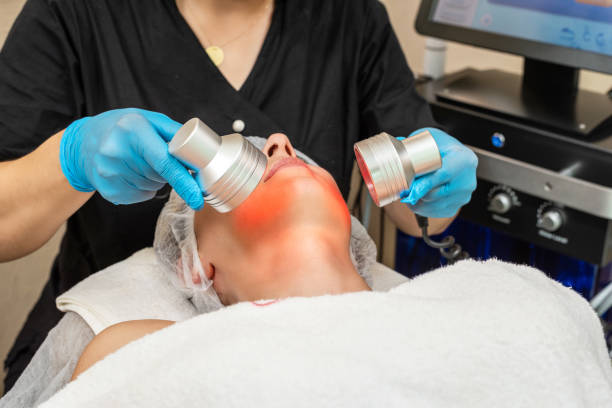
Many people wonder if microdermabrasion is safe, especially when it comes to the question of whether or not microdermabrasion hurts. People are worried that the procedure may be too harsh or uncomfortable. Let’s take a look at the answers to this question so that you can make an informed decision about microdermabrasion.
Overview of Microdermabrasion
Microdermabrasion is a non-invasive cosmetic procedure that involves using a special machine to exfoliate and remove the outer layer of dead skin cells from the face, revealing smoother, brighter, and younger-looking skin. The procedure is generally safe, but there are some risks and side effects to consider, such as skin redness, swelling, sensitivity, and bruising. However, these side effects are usually temporary and mild, and most people can return to their normal activities immediately after the treatment.
Another common question that people ask about microdermabrasion is whether the procedure hurts. While everyone’s pain tolerance is different, the majority of people describe the treatment as mild or slightly uncomfortable, with some feeling a slight scratching or stinging sensation on the skin. If you have sensitive skin, you may experience more discomfort during the treatment, but your dermatologist or aesthetician can adjust the settings of the machine to minimize any pain or irritation.
How Microdermabrasion Works
Microdermabrasion is a gentle, non-invasive procedure that uses a diamond-tipped wand or fine crystals to exfoliate the skin’s surface, removing dead skin cells and revealing smoother, brighter skin.
Is Microdermabrasion Safe? Yes, it is a safe procedure that is suitable for all skin types. It does not involve the use of any harsh chemicals, and unlike other skin resurfacing treatments, it does not require anesthesia or downtime. Does Microdermabrasion hurt? No, the procedure is virtually painless and does not require any anesthesia. Some people may experience mild discomfort or a slight tingling sensation during the treatment, but this usually subsides quickly. After the procedure, the skin may feel slightly tight or tingly, but this is normal and temporary.
Pro Tip: For best results, it is recommended to undergo a series of microdermabrasion treatments spaced a few weeks apart. This will help to improve the appearance of fine lines, wrinkles, acne scars, and hyperpigmentation, and rejuvenate the overall appearance of your skin.
Possible Risks and Side Effects
Microdermabrasion is a safe and minimally invasive cosmetic procedure that helps improve the appearance of fine lines, wrinkles, age spots, acne scars, and dull skin. However, like any procedure, it carries the risk of potential side effects.
Here are some possible side effects of microdermabrasion:
- Skin irritation: Some people may experience mild redness, swelling, and tenderness after microdermabrasion. This is normal and typically fades within a few hours to a day.
- Infection: In rare cases, microdermabrasion can lead to infection if the equipment or materials used during the treatment are not properly sterilized.
- Burns: Microdermabrasion can cause burns or abrasions if the device is set at a higher intensity or if the skin is too thin or sensitive.
- Changes in pigmentation: People with darker skin tones may be at risk of developing uneven skin tone or hyperpigmentation (darkened patches on the skin) after microdermabrasion.
However, most people who undergo microdermabrasion experience few or no side effects. The procedure is generally well-tolerated and does not hurt. A mild tingling or scratching sensation may occur during the treatment, but the intensity can be adjusted to the patient’s comfort level. Pro tip: Talk to your dermatologist or skin care specialist to determine if microdermabrasion is right for you and to discuss any potential risks or side effects.

Does Microdermabrasion Hurt
Microdermabrasion is a popular cosmetic procedure that is used to treat a variety of skin concerns. It is usually done in a spa or beauty salon, and involves exfoliating the top layer of skin. Many people are curious if this procedure is painful and if it is safe. Let’s take a closer look to answer the question of “Does microdermabrasion hurt?”.
Pain Level During Microdermabrasion
Microdermabrasion is a safe and relatively painless cosmetic procedure that can help exfoliate dead skin cells and improve the appearance of fine lines and acne scars. While it is considered a non-invasive treatment, some people may experience discomfort or mild pain during the procedure. The level of pain during microdermabrasion can vary depending on your skin type, the intensity of the treatment, and the skill level of the person performing it. Some common sensations people feel include mild scratching or stinging, as well as a suctioning sensation.
However, most people find the procedure to be tolerable and experience no lingering pain or discomfort afterward. If you have sensitive skin or are concerned about pain, talk to your dermatologist or aesthetician before scheduling a microdermabrasion treatment. They can advise you on how to prepare for the treatment and manage any discomfort you may feel during the procedure.
Factors Affecting Pain Level
Microdermabrasion is a safe skincare procedure used to remove dead skin cells and improve skin texture. The level of pain experienced during the procedure varies from person to person and depends on multiple factors.
The following are some of the factors that can affect the pain level during microdermabrasion:
- Skin sensitivity: Individuals with sensitive skin are more likely to experience discomfort during microdermabrasion. The sensation can range from mild stinging to more intense burning or scratching.
- Depth of abrasion: The deeper the microdermabrasion, the more likely it is to cause pain. A mild to moderate level of abrasion is generally well tolerated by most individuals.
- Pressure of the device: The pressure used by the microdermabrasion device can impact the pain level. High levels of pressure can lead to more discomfort during the procedure.
- Skilled practitioner: Like any other medical procedure, the skill and experience of the practitioner can influence the pain level. A skilled practitioner can minimize discomfort by adjusting the settings and technique used during the procedure.
While microdermabrasion is generally considered a safe and minimally invasive procedure, it is always best to discuss any concerns or questions regarding pain levels with your practitioner before the procedure.
Pro Tip: To minimize the pain level during microdermabrasion, it’s essential to find a skilled practitioner who can customize the treatment to your specific needs and skin type.
Comparison to Other Skin Procedures
Microdermabrasion is a gentle and safe skin procedure that has become increasingly popular over the last few years. Compared to other skin procedures, such as chemical peels or laser resurfacing, microdermabrasion is a less invasive and less painful option.
Chemical peels can be painful, causing burning and stinging sensations, redness, and flaking of the skin afterward. Laser resurfacing can also be uncomfortable and may require local anesthesia. In contrast, microdermabrasion causes only mild discomfort, similar to a light scratching or tingling sensation. It is also safe for most skin types and does not require any downtime. While microdermabrasion is not a substitute for more intensive treatments, such as chemical peels or laser resurfacing, it is a great option for those seeking a non-invasive and effective method for reducing fine lines, hyperpigmentation, and other skin imperfections.
Pro Tip: Before opting for any skin procedure, make sure to consult with a licensed dermatologist or esthetician to determine which option is best for your skin type and condition.
Precautions to Take Before Microdermabrasion
Microdermabrasion is a cosmetic procedure that can help improve the look of your skin. However, it is important to practice caution before choosing this type of treatment and understand the potential risks involved. Here, we will discuss what precautions should be taken before undergoing a microdermabrasion treatment and whether or not it is safe for everyone.
Choosing a Qualified Professional
Microdermabrasion is a popular cosmetic procedure to exfoliate and rejuvenate the skin. To ensure a safe and effective treatment, it is essential to choose a qualified professional. Here are some precautions to take before microdermabrasion and to answer your question – Does Microdermabrasion hurt?
- Research potential service providers: Before scheduling the procedure, research and verify the qualifications, credentials, and experience of the professional. Choose someone who has conducted several successful microdermabrasion treatments and has received positive reviews.
- Check the equipment: Ensure that the service provider uses the latest equipment and follows proper hygiene and sanitation practices to avoid any infection.
- Discuss medical history: Inform the professional about any medical history, skin sensitivities, allergies, or ongoing treatments before the treatment to avoid any adverse reactions.
- Discuss pain management: Microdermabrasion, by nature, is a painless procedure which only causes slight discomfort. However, if the sensation continues to bother you or is painful, speak up to your service provider. They may suggest a topical numbing cream or adjust the intensity of the procedure.
Following these precautions will help you achieve a safe and effective microdermabrasion treatment, ensuring great results with minimal discomfort.
Discussing Medical History with Professional
Before undergoing microdermabrasion, it’s crucial to have an open and honest discussion about your medical history with a skincare professional to ensure that the treatment is safe and effective for you.
Here are some precautions to take:
- Inform the skincare professional about any current or past medical conditions, including skin conditions, allergies, or medications you are currently taking.
- If you are prone to cold sores, discuss prophylaxis options before the treatment.
- Avoid excessive sun exposure, tanning, or using self-tanning products for a week before the treatment.
- Refrain from using any exfoliating products or treatments, including retinoids, AHAs, or BHAs, for a week before the treatment.
Also, it’s worth noting that microdermabrasion is generally considered safe and does not cause pain. However, some people may experience mild discomfort or stinging sensation during the procedure. This can be managed by informing the skincare professional and using numbing cream, if necessary.

Preparing Your Skin for the Procedure
Microdermabrasion is a safe and minimally invasive procedure that can help improve the appearance of skin texture, acne scars, fine lines, and age spots. However, before the procedure, it’s important to prepare your skin to ensure the best possible results and reduce any potential discomfort.
Here are some precautions to take before microdermabrasion:
- Avoid sun exposure and tanning beds, for at least a week before your treatment.
- Discontinuing the use of any skin-thinning medications, like Retin-A, for at least three days before your appointment.
- Drink plenty of water the day before and day of the procedure to prevent dehydration.
- Avoid using any products that contain alpha and beta hydroxy acids or glycolic and salicylic acids 24 hours before and after your appointment.
- Inform your aesthetician about any skin allergies or sensitivities you may have.
Lastly, you may experience a slightly uncomfortable feeling during the procedure, but with the help of numbing creams or cooling gels, the discomfort can be kept to a minimum level.
Aftercare Instructions for Microdermabrasion
Microdermabrasion is a safe and effective procedure to reduce the appearance of fine lines and wrinkles. It is a fast, non-invasive way to improve your skin’s texture and can be done in the comfort of your own home. After a treatment, there are aftercare instructions that should be followed to ensure a safe and successful session. This section will talk more in depth on the aftercare instructions for microdermabrasion.
Following Post-Treatment Guidelines
Microdermabrasion is a minimally invasive cosmetic procedure that can do wonders for your skin, but it’s important to follow post-treatment guidelines to ensure good results and avoid complications.
Here are some aftercare instructions that will help you get the most out of your microdermabrasion treatment:
- Stay out of the sun and avoid strenuous exercise for at least 24 hours after the treatment.
- Keep your skin moisturized and hydrated to help it heal faster.
- Avoid using exfoliating scrubs, AHAs, BHAs, or retinol products for at least a week after the procedure.
- Be gentle with your skin and avoid rubbing or scratching it, as it can cause irritation.
Microdermabrasion is generally a safe and painless procedure, but it may cause some discomfort, especially during the first few treatments. However, the discomfort is usually mild and tolerable, and it should subside quickly. Remember to communicate with your esthetician if you are experiencing significant pain during the treatment, so they can make adjustments to the procedure.
Pro tip: To make your microdermabrasion treatment more comfortable, consider taking a painkiller such as ibuprofen before the procedure, and avoid doing it during your menstrual cycle as the skin can be extra sensitive during that time.
Avoiding Sun Exposure After Procedure
Microdermabrasion is a safe and non-invasive procedure used to reveal younger-looking skin by removing dead skin cells from the surface of your skin. While the procedure is generally painless, it may cause some temporary sensitivity to sun exposure, so it’s important to avoid direct sunlight after treatment.
Here are some aftercare instructions to follow:
- Immediately after microdermabrasion, apply a broad-spectrum sunscreen with an SPF of at least 30 to protect your skin from the sun’s harmful rays.
- Wear a wide-brimmed hat and avoid prolonged sun exposure for at least a few days after the procedure.
- Avoid hot tubs, saunas, and steam rooms for at least 48 hours after the treatment.
- Do not use exfoliating scrubs or acids, including glycolic, salicylic, or retinoic acid, for a few days following the procedure.
- If your skin feels dry or flaky after the treatment, use a gentle moisturizer to hydrate and soothe your skin.
Pro tip: Following these aftercare instructions will help ensure optimal results and avoid any potential side effects.
Managing Potential Side Effects
Microdermabrasion is a minimally invasive cosmetic procedure used to improve the appearance of skin texture, tone, and overall radiance. While generally considered safe, like any cosmetic treatment, it can cause some side effects that need to be managed.
Here are some common side effects:
- Skin redness and sensitivity: This is normal and usually subsides within a day or two.
- Dryness and flakiness: Use a moisturizer to keep your skin hydrated.
- Bruising: This is rare but may occur in people with thin or sensitive skin.
- Mild stinging and itching: Avoid scratching or rubbing the treated area and apply a cool compress to soothe any discomfort.
Following aftercare instructions can help minimize potential side effects and ensure optimal results. As for microdermabrasion, it is generally a painless procedure, but you may experience some discomfort or mild stinging during the treatment.
Conclusion
So, does microdermabrasion hurt? The answer is that it depends. It can cause some mild discomfort such as a mild tingling sensation, but it is generally considered safe and does not cause any serious pain. Microdermabrasion is a popular treatment for many skin concerns, but the side effects and risks should be discussed with an experienced dermatologist before moving forward.
Overall Safety of Microdermabrasion
Microdermabrasion is a non-invasive cosmetic treatment that is designed to exfoliate and improve the texture and appearance of the skin. When done correctly, microdermabrasion is generally safe and does not cause any significant pain or discomfort.
However, it is important to note that like any cosmetic treatment, there are some potential risks and side effects associated with microdermabrasion, especially if it is not performed by a trained professional. Some of the risks and side effects of microdermabrasion include redness, swelling, bruising, and skin sensitivity. In rare cases, the treatment may cause scarring, infection, or hyperpigmentation.
To minimize the risk of any adverse effects, it is important to choose a reputable and experienced provider for your microdermabrasion treatment. Additionally, follow your provider’s instructions for before and aftercare to ensure that your skin heals properly.
Pro tip: If you are new to microdermabrasion, start with a low intensity and build up gradually to assess your tolerance.
Understanding Pain Sensitivity For Procedure
Microdermabrasion is a cosmetic skin treatment that uses a machine to exfoliate the top layer of skin. The procedure does not typically cause pain, but there may be some discomfort or sensitivity depending on an individual’s pain threshold. Pain sensitivity varies from person to person, so it is difficult to predict how someone will feel during a microdermabrasion procedure. However, it is important to note that the sensation should be more akin to a feeling of mild scraping or tingling rather than actual pain.
Some people with sensitive skin or low pain tolerance may feel some discomfort during the procedure, but it is usually temporary and can be managed with topical anesthetic or over-the-counter pain medication. Overall, microdermabrasion is considered a safe and non-invasive cosmetic treatment that produces minimal discomfort, making it an excellent option for people who want to improve their skin’s overall appearance.

